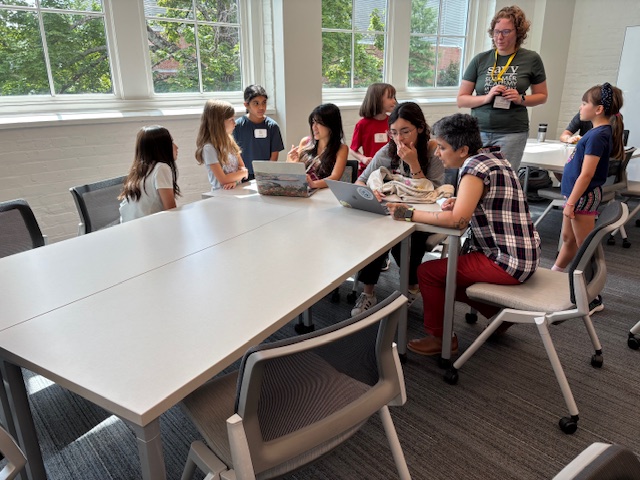Summer SAVY, Session 4 Day 5, “Coding and Robotics” (3rd-4th)
What a week! The student programmers quickly learned the skills presented in this course and are ready to take on new challenges in coding and robotics. Not only were they quick learners, but this group also showed exceptional teamwork and collaboration skills. Each toy company team worked hard to complete their challenges. Everyone’s ideas were heard and considered, and each group synthesized the thinking of individuals to come up with outstanding solutions. The ability to work cohesively with peers you’ve only known for a few days is a valuable life skill. Miss Kat and I talked daily about how impressed we were with the interpersonal skills of this group of students. It was a joy to watch them learn together.
Our morning field trip was to a VSA class on campus. They are doing an in-depth study of Python programming. Dr. Dash demonstrated the code needed to find amenities that college students may use on a map of the region surrounding Vanderbilt’s campus. She explained the lines of programming that assigned each amenity a value (1-4) based on significance. The size of the circle for each location on the map corresponded to the value assigned. Our class had the chance to watch the VSA students while they were programming and engage by asking questions. Ask your child what they learned from the high school students.
This was the fictional scenario for our final challenge: “Exciting news: Lego wants to sell your dancing robot in their stores! Since you are talented engineers, they asked you to help them solve a problem at Lego Stores. Kids can’t reach boxes on higher shelves. To solve this problem, they are redesigning the store. They asked you to create an autonomous driving machine that can retrieve a box from the backroom and deliver it to a customer when they place their order at the new touch screen ordering kiosks.” They were given constraints and criteria for the mission. They used the engineering design process to design and program an attachment for the robot that could secure and move the toy box as the robot followed the line.
To complete the challenge, each toy company team built an advanced driving base. This proved to be an opportunity to use creative problem-solving skills when we discovered that our kits didn’t have some of the pieces. Students thought about the function of each piece and found substitutes or redesigned that section of the robot to produce the same outcome. I taught them about “passive attachments,” which don’t require code, and they came up with several creative designs. Unfortunately, time wasn’t on our side, and we had to clean up before completing the full challenge. Even with this change of plans, the trial-and-error used to improve outcomes was an excellent example of how the engineering design process helps us work through productive struggles.
Coding Opportunities for Home:
- Your child received a gift book today about Python code. The book includes instructions about how to download Python on a Mac or PC. This book does a great job outlining the steps to get started with Python and can be used for self-guided learning. Python was introduced in this class, but students did not use it with the Spike robots. This will be a great way to extend their learning!
- Code.org is a great free resource. The foundations of coding courses move at the pace of your child. I recommend this path if you choose this resource. The Hour of Code website also has free code.org games that don’t require an account.
- MIT’s Scratch program is a free online coding resource designed for children. The activities are free and use block code. https://scratch.mit.edu/
Let me reiterate how much I enjoyed working with this group of programmers! They were engaged, enthusiastic, and eager to learn. Enjoy the rest of your summer. Hopefully, I will see your child at SAVY in the future!
Ms. Allison

